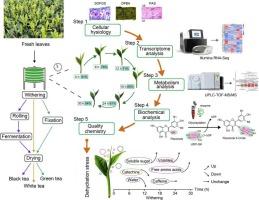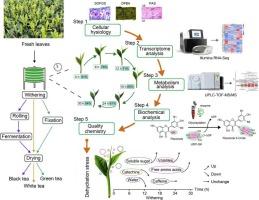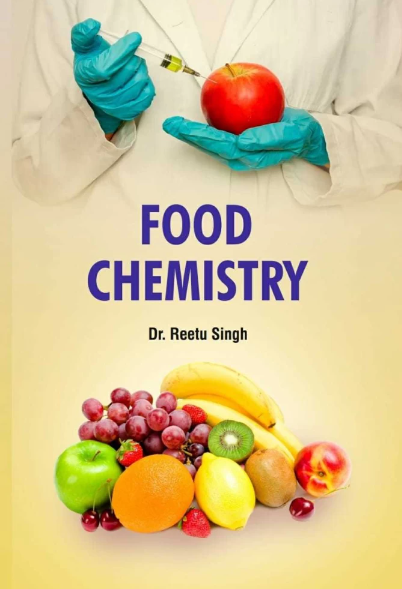A comprehensive study of the physiology and chemistry of tea withering based on untargeted metabolomic, transcriptomic, and biochemical analyses
IF 8.5
1区 农林科学
Q1 CHEMISTRY, APPLIED
引用次数: 0
Abstract
Withering is an important process for achieving high-quality flavor in tea. In this study, histological, metabolomics, transcriptomics, and biochemical analyses were combined to comprehensively explore the accumulation and molecular regulatory profiles of quality metabolites during tea withering. The results of tissue staining indicated that as the water content decreased, the vitality of the nucleus weakened, cytoplasmic content increased, flavone content decreased, and proteins degraded. Omics analysis showed that the total content of soluble sugars, free amino acids, and terpenoids increased, whereas that of catechins decreased significantly, although the caffeine content barely changed. Biochemical analysis revealed that the translated products of genes CSA010827 and CSA001819 catalyzed the biosynthesis of galactose and flavanol 3-O-glycosides, respectively, thereby increasing the content of soluble sugars and contributing to the astringent taste. Overall, by combining omics with histological and biochemical analyses, we revealed the metabolic profile and possible molecular mechanisms during the withering process of tea.


基于非靶向代谢组学、转录组学和生化分析的茶叶萎凋生理和化学综合研究
萎凋是实现茶叶高品质风味的重要过程。本研究结合组织学、代谢组学、转录组学和生化分析,全面探讨了茶叶萎凋过程中优质代谢物的积累和分子调控特征。组织染色结果表明,随着含水量的降低,细胞核活力减弱,细胞质含量增加,黄酮含量降低,蛋白质降解。Omics 分析表明,可溶性糖、游离氨基酸和萜类化合物的总含量增加,而儿茶素的总含量显著下降,但咖啡因的含量几乎没有变化。生化分析表明,基因 CSA010827 和 CSA001819 的翻译产物分别催化了半乳糖和黄烷醇 3-O 糖苷的生物合成,从而增加了可溶性糖的含量,并导致了涩味。总之,通过将 omics 与组织学和生化分析相结合,我们揭示了茶叶萎凋过程中的代谢概况和可能的分子机制。
本文章由计算机程序翻译,如有差异,请以英文原文为准。
求助全文
约1分钟内获得全文
求助全文
来源期刊

Food Chemistry
工程技术-食品科技
CiteScore
16.30
自引率
10.20%
发文量
3130
审稿时长
122 days
期刊介绍:
Food Chemistry publishes original research papers dealing with the advancement of the chemistry and biochemistry of foods or the analytical methods/ approach used. All papers should focus on the novelty of the research carried out.
 求助内容:
求助内容: 应助结果提醒方式:
应助结果提醒方式:


